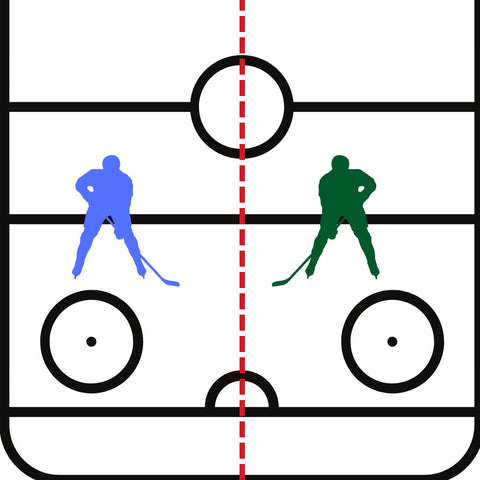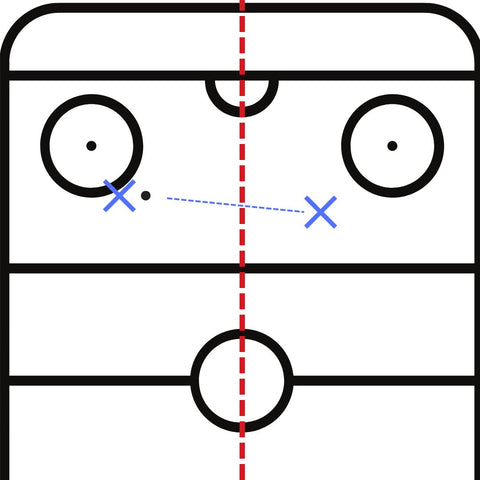Breaking Down a One-timer
The skill of a one-timer is one of the most flashy and impressive skills in hockey. We have all seen Ovechkin rocket a shot from his knee through the traffic, leaving the goalie with no hope of saving it on the power play. It’s always such an exciting goal, and it looks so easy as it flings into the net.
The definition of a one-timer is simple: It is a shot that comes right off the pass, with no stickhandling or collection of the puck by the player. There are a number of situations and shots that happen in a game, but for the sake of this article, we will be focusing on the traditional one-timer. Usually on a powerplay, the player is positioned with their stick to the middle, meaning if they are standing facing the net, their stick would be towards the middle of the ice, not the wall. Here’s a visual:

Typically, on a powerplay the goal will be to move the puck across the seam (see the red dotted-line) so that they can utilize the player with a strong one-timer. The most classic example is the Washington Capitals, and Alex Ovechkin. They will have tons of movement and passing with the other 4 players on the ice to work the penalty killers out of position, and then Ovechkin will get into his sweet spot on the ice, and when the penalty killers leave the slightest bit of space, they’ll pass it across the seam and he’ll hammer it home. It’s the way he’s perfected this shot that has him close to beating the all-time record for goals in the NHL.
A one-timer like this can happen in 5v5 play as well, but it can be hard to facilitate because the player needs time and space in order to get the shot off, and for the most part it’s difficult to gain that needed separation.
For a great one-timer to beat the goalie, the pass is more important than the shot position. The pass is the play that beats the goalie, and can give the shooter the opportunity to quickly put the puck away. For this pass to work, there is usually deception and skill involved, along with correct timing for the shooter to line up the shot.
Here’s another visual of where a common one-timer comes from. The puck sliding across the seam. The reason this works, is because it forces the goalie to move the entire way across the net, which takes time and increases the likelihood of mistakes and positioning errors.

The mechanics of the one-timer is more detailed than it may seem at face value. Apart from on-ice positioning, there are 8 parts of your body that must be in connection in order to properly execute a one-timer.
Head: In the game, being able to receive as much information and compute quicker than the opposition all over the ice. Your head, and your eyes, need to be able to see the puck and track it successfully in order to have the puck go off your stick. Moreover, before the pass comes, your head needs to look at the net and see the goalie, the defenders, and where the other players are. Sometimes, a second cross-seam pass can work better than a simple one-timer at the net. The head needs to be able to track so many things on the ice, and then the focus needs to transition to the blade hitting the puck. As the puck hits, it helps to have your eyes follow the stick, pointing at the net and where the puck should be going. This is the best way to ensure the rest of the body follows through, which will generate more power and accuracy behind the puck. The head dictates the entire process of the one-timer.
Chest: The chest plays a crucial role in being the steady middle space between the legs, arms, and head. The chest should be in a neutral position, and move to face the net as the puck goes in.
Arms: While the arms hold the stick, it’s important to realize that more power comes from the legs than the length of the wind-up. Making sure to connect with the ice, just before the puck, and think of the stick as a pendulum is key to a great one-timer. The stick should point towards the net with the toe, which requires the shooter to turn their wrists. That’s why a lot of pucks will sail over the net, because this crucial detail was skipped. Having a huge wind-up isn’t necessary to power, and it can be detrimental because of the time it takes to go all the way up and all the way down from such a high position.
Hips/Legs: The lower half of the body is the most important generator of power for the one-timer. Both need to be a part of the transition from the pass to the puck going towards the net. Like physics, the process of a one-timer is about gaining power and changing the motion of the puck. The legs need to be bent, and the hips need to be square to the pass, until the front leg (led by the foot) turns to face the net and moves the entire body follows the puck. I had a coach that used to say, “you can’t shoot a cannon out of a canoe” meaning that legs need to be bent and strong in order to shoot the puck with enough pace to beat the goalie.
Feet: If a one-timer is a song, the feet are the conductor. They need to be connected together, and separate in order to bring the entire shot together. As the puck is coming, the front foot and hip should open to point at the net, so the momentum can all go towards the net. This is why players will go to a knee, to drive extra strength and power towards the net.
Puck: The puck is the part of the one-timer that depends on the player’s preference. There are three main areas where a one-timer pass can be sent. Towards the front foot, in the middle, and off the back foot. It’s really a matter of communication between the passer and shooter for where they want the puck to go. Here’s a visual:

The one-timer is a great shot that can make a powerplay lethal when set up properly. Having a strong one-timer is incredibly detailed and in order to become great at it, repetition off ice is key. The PassMaster by Sniper’s Edge will help to deliver pass after pass perfectly to the sweet zone where you can become an expert at the one-timer.


